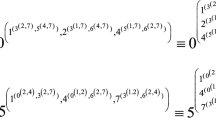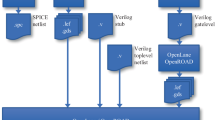Abstract
This paper extends the concept of Karnaugh map from a logical function to a logical system, thereby allowing both the state transition graph and state transition matrix of a logical system, as well as a digital circuit, to be constructed directly. It is found that the Karnaugh map of a logical system is actually a two-dimensional state transition table or, equivalently, a table-like state transition graph and is also a grid-type state transition matrix. For constructing the state transition graph and state transition matrix of a logical system, the computational complexities of the methods based on the proposed Karnaugh map are exponentially lower than those of the existing methods. The Karnaugh maps of logical systems are then used in the analysis and design of clocked sequential circuits and in the simplification of multioutput gate circuits. Some illustrative examples and simulations are presented to demonstrate the results and their applications.




















Similar content being viewed by others
Notes
Hereafter, row (resp. square) i refers to the row (resp. square) that is numbered as i.
Hereafter, the ‘jth bit code’ means the ‘jth bit code from the left’.
Hereafter, the logical values 1 and 0 are replaced by \(\delta _{2}^{1}\) and \(\delta _{2}^{2}\), respectively.
References
T. Akutsu, M. Hayashida, W. Ching, M.K. Ng, Control of Boolean networks: hardness results and algorithms for tree structured networks. J. Theor. Biol. 244(4), 670–679 (2007)
S.M. Burns, Performance Analysis and Optimization of Asynchronous Circuits. Ph.D. Thesis, California Institute of Technology, Pasadena (1990)
D. Cheng, H. Qi, Controllability and observability of Boolean control networks. Automatica 45, 1659–1667 (2009)
D. Cheng, H. Qi, A linear representation of dynamics of Boolean networks. IEEE Trans. Autom. Control 55(10), 2251–2258 (2010)
J. Cochet-Terrasson, S. Gaubert, J. Gunawardena, A constructive fixed point theorem for min–max functions. Dyn. Stab. Syst. 14(4), 407–433 (1999)
K. Das, D. De, M. De, Modified ternary Karnaugh map and logic synthesis in ternary quantum dot cellular automata. IETE J. Res. 62(6), 774–785 (2016)
S. Gaubert, J. Gunawarden, The duality theorem for min–max functions. C. R. Acad. Sci. Ser. I Math. 326(1), 43–48 (1998)
J. Gunawardena, Timing analysis of digital circuits and the theory of min–max functions. In: Tau93 Acm International Workshop on Timing Lssues in the Specification and Synthesis of Digital Systems (Malente 1993), pp. 1–9
J. Gunawardena, Min–max functions. Discrete Event Dyn. Syst. Theory Appl. 4(4), 377–407 (1994)
A.W. Hassan, A.K. Hassan, A Karnaugh map based approach towards systemic reviews and meta-analysis. SpringerPlus 5, 371 (2016)
G. Hochma, M. Margaliot, E. Fornasini, M.E. Valcher, Symbolic dynamics of Boolean control networks. Automatica 49, 2525–2530 (2013)
H. Hulgaard, S.M. Burns, T. Amon, G. Borriello, An algorithm for exact bounds on the time separation of events in concurrent systems. IEEE Trans. Comput. 44(11), 1306–1317 (1995)
M. Karnaugh, The map method for synthesis of combinational logic circuits. Trans. Am. Inst. Electr. Eng. Part I 72(9), 593–599 (1953)
M. Kubica, D. Kania, Decomposition of multioutput functions oriented to configurability of logic blocks. Bull. Pol. Acad. Sci. Tech. Sci. 65(3), 317–331 (2017)
M. Nosrati, R. Karimi, R. Aziztabar, Minimization of Boolean functions which include don’t-care statements, using graph data structure, in Advances in Wireless, Mobile Networks and Applications (Heidelberg, 2011), pp. 212–220
G.J. Olsder, Eigenvalues of dynamic max–min systems. Discrete Event Dyn. Syst. Theory Appl. 1(2), 177–207 (1991)
V.C. Prasad, On Boolean techniques for non touching loops of signal flow graphs. Circuits Syst. Signal Process. 32(3), 1443–1453 (2013)
D.S. Rajput, R.S. Thakur, G.S. Thakur, Karnaugh map approach for mining frequent termset from uncertain textual data. Br. J. Math. Comput. Sci. 4(3), 333–346 (2014)
C.H. Roth, L.L. Kinney, Fundamentals of Logic Design, seven edn. (Cengage Learning, Stamford, 2014)
A.M. Rushdi, H.A. Al-Yahya, A Boolean minimization procedure using the variable-entered Karnaugh map and the generalized consensus concept. Int. J. Electron. 87(7), 769–794 (2000)
A.M. Rushdi, F. Ghaleb, A tutorial exposition of semi-tensor products of matrices with a stress on their representation of Boolean functions. J. King Abdulaziz Univ. 5, 3–41 (2016)
K.A. Sakallan, T.N. Mudge, O.A. Olukotun, Analysis and design of latch-controlled synchronous digital circuits. IEEE Trans. Comput. Aided Des. Integr. Circuits Syst. 11(3), 322–333 (1992)
W.G. Schneeweiss, Boolean Functions with Engineering Applications and Computer Programs (Springer, London, 1989)
Y. Tao, G.P. Liu, State feedback stabilization and majorizing achievement of min–max-plus systems. IEEE Trans. Autom. Control 50(12), 2027–2033 (2005)
Y. Tao, G.P. Liu, W. Chen, Globally optimal solutions of max–min systems. J. Glob. Optim. 39(3), 347–363 (2007)
Y. Tao, G.P. Liu, X. Mu, Max-plus matrix method and cycle time assignability and feedback stabilizability for min–max-plus systems. Math. Control Signals Syst. 25(2), 197–229 (2013)
S. Wisetphanichkij, K. Dejhan, The combinational and sequential adiabatic circuit design and its applications. Circuits Syst. Signal Process. 28(4), 523–534 (2009)
X. Yu, W. Lian, J. Zhang, H. Liu, Multi-input and -output logic circuits based on bioelectrocatalysis with horseradish peroxidase and glucose oxidase immobilized in multi-responsive copolymer films on electrodes. Biosens. Bioelectron. 80, 631–639 (2016)
Acknowledgements
The authors would like to thank the reviewers for their comments and suggestions. This work was supported by National Natural Science Foundation of China under Grant numbers 61741307 and 60774007, and Innovation Project of Hebei under grant number CXZZBS2018032.
Author information
Authors and Affiliations
Corresponding author
Additional information
Publisher's Note
Springer Nature remains neutral with regard to jurisdictional claims in published maps and institutional affiliations.
Rights and permissions
About this article
Cite this article
Wang, C., Tao, Y. Karnaugh Maps of Logical Systems and Applications in Digital Circuit Design. Circuits Syst Signal Process 39, 2245–2271 (2020). https://doi.org/10.1007/s00034-019-01214-x
Received:
Revised:
Accepted:
Published:
Issue Date:
DOI: https://doi.org/10.1007/s00034-019-01214-x




